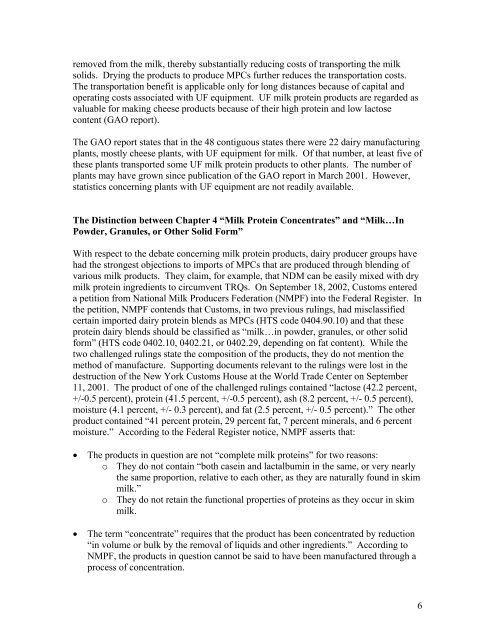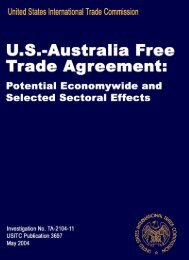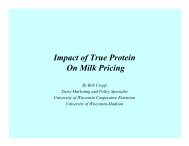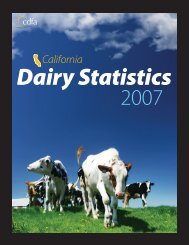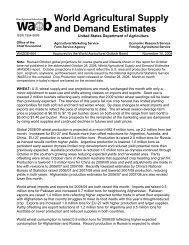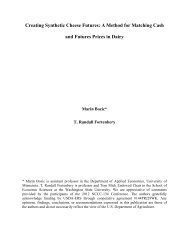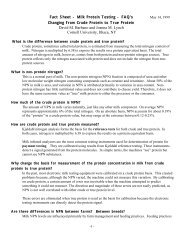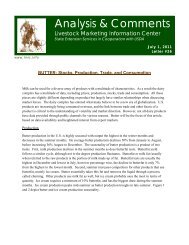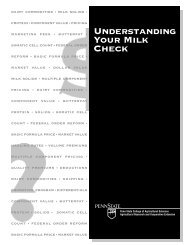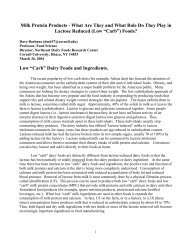Milk Protein Products and Related Government Policy Issues
Milk Protein Products and Related Government Policy Issues
Milk Protein Products and Related Government Policy Issues
Create successful ePaper yourself
Turn your PDF publications into a flip-book with our unique Google optimized e-Paper software.
emoved from the milk, thereby substantially reducing costs of transporting the milk<br />
solids. Drying the products to produce MPCs further reduces the transportation costs.<br />
The transportation benefit is applicable only for long distances because of capital <strong>and</strong><br />
operating costs associated with UF equipment. UF milk protein products are regarded as<br />
valuable for making cheese products because of their high protein <strong>and</strong> low lactose<br />
content (GAO report).<br />
The GAO report states that in the 48 contiguous states there were 22 dairy manufacturing<br />
plants, mostly cheese plants, with UF equipment for milk. Of that number, at least five of<br />
these plants transported some UF milk protein products to other plants. The number of<br />
plants may have grown since publication of the GAO report in March 2001. However,<br />
statistics concerning plants with UF equipment are not readily available.<br />
The Distinction between Chapter 4 “<strong>Milk</strong> <strong>Protein</strong> Concentrates” <strong>and</strong> “<strong>Milk</strong>…In<br />
Powder, Granules, or Other Solid Form”<br />
With respect to the debate concerning milk protein products, dairy producer groups have<br />
had the strongest objections to imports of MPCs that are produced through blending of<br />
various milk products. They claim, for example, that NDM can be easily mixed with dry<br />
milk protein ingredients to circumvent TRQs. On September 18, 2002, Customs entered<br />
a petition from National <strong>Milk</strong> Producers Federation (NMPF) into the Federal Register. In<br />
the petition, NMPF contends that Customs, in two previous rulings, had misclassified<br />
certain imported dairy protein blends as MPCs (HTS code 0404.90.10) <strong>and</strong> that these<br />
protein dairy blends should be classified as “milk…in powder, granules, or other solid<br />
form” (HTS code 0402.10, 0402.21, or 0402.29, depending on fat content). While the<br />
two challenged rulings state the composition of the products, they do not mention the<br />
method of manufacture. Supporting documents relevant to the rulings were lost in the<br />
destruction of the New York Customs House at the World Trade Center on September<br />
11, 2001. The product of one of the challenged rulings contained “lactose (42.2 percent,<br />
+/-0.5 percent), protein (41.5 percent, +/-0.5 percent), ash (8.2 percent, +/- 0.5 percent),<br />
moisture (4.1 percent, +/- 0.3 percent), <strong>and</strong> fat (2.5 percent, +/- 0.5 percent).” The other<br />
product contained “41 percent protein, 29 percent fat, 7 percent minerals, <strong>and</strong> 6 percent<br />
moisture.” According to the Federal Register notice, NMPF asserts that:<br />
• The products in question are not “complete milk proteins” for two reasons:<br />
o They do not contain “both casein <strong>and</strong> lactalbumin in the same, or very nearly<br />
the same proportion, relative to each other, as they are naturally found in skim<br />
milk.”<br />
o They do not retain the functional properties of proteins as they occur in skim<br />
milk.<br />
• The term “concentrate” requires that the product has been concentrated by reduction<br />
“in volume or bulk by the removal of liquids <strong>and</strong> other ingredients.” According to<br />
NMPF, the products in question cannot be said to have been manufactured through a<br />
process of concentration.<br />
6


